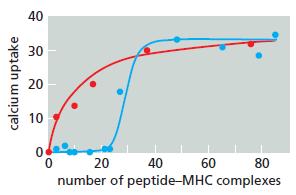CD4 proteins on helper and regulatory T cells serve as co-receptors that bind to invariant parts of
Question:
CD4 proteins on helper and regulatory T cells serve as co-receptors that bind to invariant parts of class II MHC proteins. CD4 is thought to increase the adhesion between T cells and antigen-presenting cells (APCs) that are initially connected only weakly by the T cell receptor bound to its specific peptide–MHC complex. To test this possibility, you label cell-surface MHC molecules with a fluorescently labeled peptide so that you can detect individual peptide–MHC complexes at the interface between the APCs and the T cells in a culture dish. To detect T cell responses—the sign of a productive contact—you load them with a Ca2+ indicator dye, as cytosolic Ca2+ increases when lymphocytes are active. You now count the peptide– MHC complexes at a large number of interfaces (immunological synapses) and measure the resulting uptake of Ca2+ in the adherent T cells (Figure Q24–4, red circles). When you repeat the experiment in the presence of blocking antibodies against CD4, you get a different result (blue circles). Do these results support or refute the notion that CD4 augments T cell receptor binding? Explain your answer.
Figure Q24-4

Step by Step Answer:

Molecular Biology Of The Cell
ISBN: 9780815344322
6th Edition
Authors: Bruce Alberts, Alexander D. Johnson, Julian Lewis, David Morgan, Martin Raff, Keith Roberts, Peter Walter





